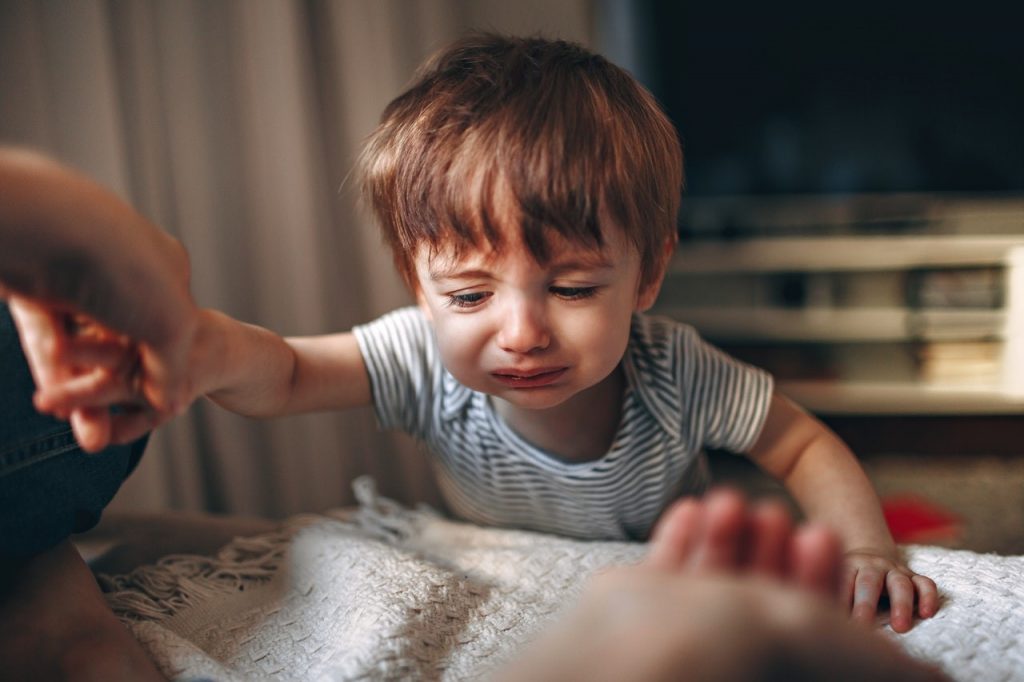Imagine this: your baby has always been a good sleeper when all of a sudden, he starts screaming his lungs out without warning in the middle of the night and wakes the entire household. What’s more, he starts displaying signs of fear and when you call out his name, he responds ever so slightly, but his eyes are still closed! What is this, you ask? This is your first encounter with the ever-dreaded night terror. It’s a sign that your baby is growing up fast and perhaps overloaded with all kinds of everyday stimuli. What to do? Hold your horses and stay calm. The last thing you want is an overwhelmed baby with a panicky mum in tow. There are ways to pre-amp this scenario and prep your baby before bedtime. Here’s all that you need to know about night terrors.
What are night terrors?
Unlike nightmares, night terrors, also referred to as sleep terrors, are partial awakenings from deep sleep. It’s usually characterised by extreme fear, screaming, and most of the time, your child is not fully awake. Night terrors occur during deep sleep and/or the transition stages between the stages of sleep. It is not associated with having a bad dream, whereas nightmares, which happen in rapid eye movement (REM) or deep sleep, occur during a dream.
Research has shown that the prevalence of night terrors in children is difficult to assess. The likelihood of them experiencing night terrors range from 1.7% to almost 56% of individuals and ages ranging from 18 months to adolescence[1]. In another study, it shows that the peak of night terrors was observed at 18 months old and as many as one-third of the children who had early childhood sleep terrors developed sleepwalking later in childhood[2]. Night terrors is considered an early childhood parasomnia (sleep disorder) and for most children, these are relatively benign.
What causes these night terrors?
Researchers suspect that night terrors is the result of over-stimulation of your child’s nervous system[3] although the actual causes are still uncertain. Non-REM sleep occurs a couple of hours after your little ones fall asleep and since studies maintain that night terrors peak when your child is around 18 months old, that is also the time when she is more aware of her surroundings and curious to know just about everything.
Other studies have shown that some factors make night terrors prevail. These include your child being overtired or sleep-deprived, illness or fever, disruptions to routines or schedules, like when you’re traveling or a change in regular daily routine at home, stress, sleep-related breathing issues like apnoea as well as family history of night terrors[4]. Basically anything to do with changes in daily routines seem to trigger off this occurrence.

What are the signs and symptoms?
The most obvious sign that your child is experiencing a night terror is if she is totally inconsolable and you might find it difficult to wake her up. This is different from when she is having a nightmare. She’ll also appear out of sorts and have a glassy-eyed expression. She won’t even remember this occurrence come morning as well. Sometimes she will be not responsive, appear upset and even act scared. More often than not, she will just fall back asleep after the episode. Other signs and symptoms would be screaming and making distress sounds, stare at you with eyes wide open (but is actually looking through you!), suddenly sit up, perspire excessively or breathe heavily, and even thrash around the bed at times.
How should you soothe your child during a night terror?
The most important thing is to stay calm when this occurs and according to sleep experts, you should not try and wake your toddler as they may end up being even more upset and disoriented. If you try to wake him, it might be more difficult for him to fall back to sleep eventually too. It is crucial to ensure that your child is safe throughout the whole event and is able to navigate back to his bed (if he starts sitting up and walking about haphazardly).

During a night terror, your tone of voice makes a whole lot of difference to how the child responds and reacts throughout the episode. Reassure him in a soothing voice and tell him that he is safe. You can also hold your child until the whole ordeal is over. Aside from this, you simply have to wait out the whole episode until he falls back asleep, just like that.
There are no sure-fire treatment or cures for night terrors, but there are methods that you can employ to lessen the occurrence of such events. Here are some of them:
- Ensure that your caregivers are aware that your child have experienced or might experience night terrors. You might even advise them on how to prevent over-stimulating your child just before bedtime and simple steps to take (as outlined above) about how to react when a night terror occurs.
- Have a consistent bedtime routine to calm your child. This can be a warm bath, massage, or just simply reading a favourite book before tucking your little one in bed.
- Set a regular bedtime (perhaps one for school nights and one for weekends and holidays). Children thrive on routine and when bedtime is set, they know what to expect and are less likely to be over-stimulated.
- If your child is clearly distressed, you can have her sleep with you, either in the same bed or just in the same room. However, this should not be a permanent arrangement or else other sleep-related problems might develop.
- Wake your child up around 15 minutes before his night terror if he seems to be having one at the same time each and every night. This might help to prevent the occurrence altogether.
- Watch for signs of stress for your toddler or if he is already of school-going age, check with the teachers if there have been changes to routine or behaviour in school.
- As mentioned above, calming a child before bedtime is important and if you know that he gets easily stimulated, try to limit activities throughout the day that might overtire him.
- If you’re traveling, try to stick to your regular home and bedtime routines as far as possible.
Night terrors may or may not occur throughout your child’s lifetime and the key is that if you are calm, so is your child. Most children will outgrow their night terror episodes without any intervention treatment. However, you should seek medical advice if the episodes occur three or more times in a week, result in injury or near injury, daily disrupted sleep or daytime lethargy, or if your child’s sleep terrors recur during adolescence or adulthood. Perhaps improving your child’s sleep hygiene should be the first step to take to prevent the frequency of night terrors.
[1] Referenced from https://www.ncbi.nlm.nih.gov/pmc/articles/PMC5941156/#eoy010-B4
[2] Referenced from https://jamanetwork.com/journals/jamapediatrics/fullarticle/2281574
[3] Referenced from https://www.ncbi.nlm.nih.gov/pmc/articles/PMC5941156/#eoy010-B4
[4] Referenced from https://jamanetwork.com/journals/jamapediatrics/fullarticle/2281574
References:
https://www.medicalnewstoday.com/articles/night-terrors-in-babies-signs-causes-and-treatment
https://www.healthline.com/health/parenting/baby-night-terrors
https://www.sleepfoundation.org/parasomnias/night-terrors
https://kidshealth.org/en/parents/terrors.html
https://www.verywellfamily.com/what-to-do-about-infant-night-terrors-4174298













